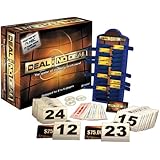The thrill of chance, the allure of risk, and the excitement of potential wealth—these are the cornerstones of the popular game show “Deal or No Deal,” which has transitioned into a captivating board game. In this article, we will explore the mechanics, strategies, and psychological factors that make the “Deal or No Deal” board game an exhilarating experience for players of all ages. By understanding its structure and the thrill it provides, we can appreciate why this game continues to capture the attention of many.
The Evolution of Deal or No Deal

Originally airing in the Netherlands as “Miljoenenjacht,” “Deal or No Deal” swiftly gained international popularity, leading to numerous adaptations. The board game version was released to extend the excitement beyond television. This board game allows players to experience the same suspenseful decision-making that characterizes the show.
Understanding the Game Mechanics

The “Deal or No Deal” board game is designed for 2 to 8 players and is based on the same principles as the television show. Here’s how it works:
- Setup: Players select a set of sealed boxes that contain varying amounts of play money, some as low as a penny and others significantly higher.
- Game Rounds: Players take turns opening boxes, revealing the amounts within, which gradually reduces the pool of potential winnings.
- The Banker: After a certain number of boxes are opened, a fictional banker offers a deal to buy the player out, which they can either accept or decline.
- Final Decision: If players refuse the offer, they continue to open more boxes until they decide to take a deal or reveal their final box.
The Thrills of Decision-Making
The heart of “Deal or No Deal” lies in the decision-making process. Players face the dilemma of whether to accept the banker’s offer or continue playing in hopes of winning a larger amount. This aspect adds layers of psychological thrill to the game:
- The Risk-Reward Balance: Players must weigh the risk of losing potential winnings against the security of a guaranteed amount.
- Emotional Investment: As players open boxes, they become emotionally invested in the game, with their excitement or disappointment influencing their decisions.
- Pressure from Peers: The social environment of the board game can exert additional pressure, making decisions feel weightier.
Strategies for Success

While luck plays a significant role, strategy can also dictate success in “Deal or No Deal.” Here are some strategies players can employ:
- Know the Odds: Understanding the probability of higher amounts remaining can guide decision-making. Players can calculate the average of remaining boxes to gauge whether to accept a deal.
- Stay Calm Under Pressure: Emotional reactions can cloud judgment. Keeping a cool head may help players make more rational decisions.
- Observe Other Players: Watching how others react to offers can provide insights into their strategies and inform your own decisions.
Case Studies: Real-Life Implications
Several studies have examined how the decision-making processes in games like “Deal or No Deal” can translate to real-life situations. For example:
- Risk Aversion: Research shows that people often exhibit risk-averse behavior when faced with uncertain outcomes. A study published in the “Journal of Behavioral Decision Making” noted that participants were more likely to accept lower guaranteed offers than to gamble for potentially higher returns.
- Group Dynamics: In a study by the “American Psychological Association,” it was found that participants in group settings often mirrored each other’s decisions, suggesting that peer influence can significantly impact risk assessment.
The Role of Randomness and Luck

In “Deal or No Deal,” the element of chance is pivotal. The randomness of box selection means that players cannot predict outcomes, which adds to the game’s excitement. This unpredictability can lead to surprising moments:
- Unexpected Wins: Players may find high amounts in boxes they least expect, leading to thrilling revelations.
- Disappointment: Conversely, players can also face unexpected losses, which heightens the emotional stakes of the game.
The Social Aspect of the Game

One of the most delightful aspects of the “Deal or No Deal” board game is its ability to bring people together. The game’s design encourages interaction and engagement:
- Family Bonding: The game is suitable for all ages, making it an excellent option for family game nights.
- Competitive Spirit: The thrill of competition can lead to lively discussions and banter, enhancing the fun.
- Shared Experiences: Players often share their decision-making experiences, fostering a sense of community.
Conclusion: The Last Deal

In summary, the “Deal or No Deal” board game encapsulates the essence of risk, reward, and the thrill of decision-making. Its blend of chance and strategy, coupled with the social dynamics it fosters, makes it a compelling choice for game enthusiasts. Whether you are a casual player or a competitive strategist, the game offers an engaging experience that reflects the complexities of real-life decision-making.
The game’s ongoing popularity underscores its ability to provide entertainment while also serving as a lens through which we can explore human behavior and psychology. As players gather around the board, they not only seek to win but also to forge connections and create memorable experiences. No matter the outcome, the journey of playing “Deal or No Deal” is an adventure worth taking.